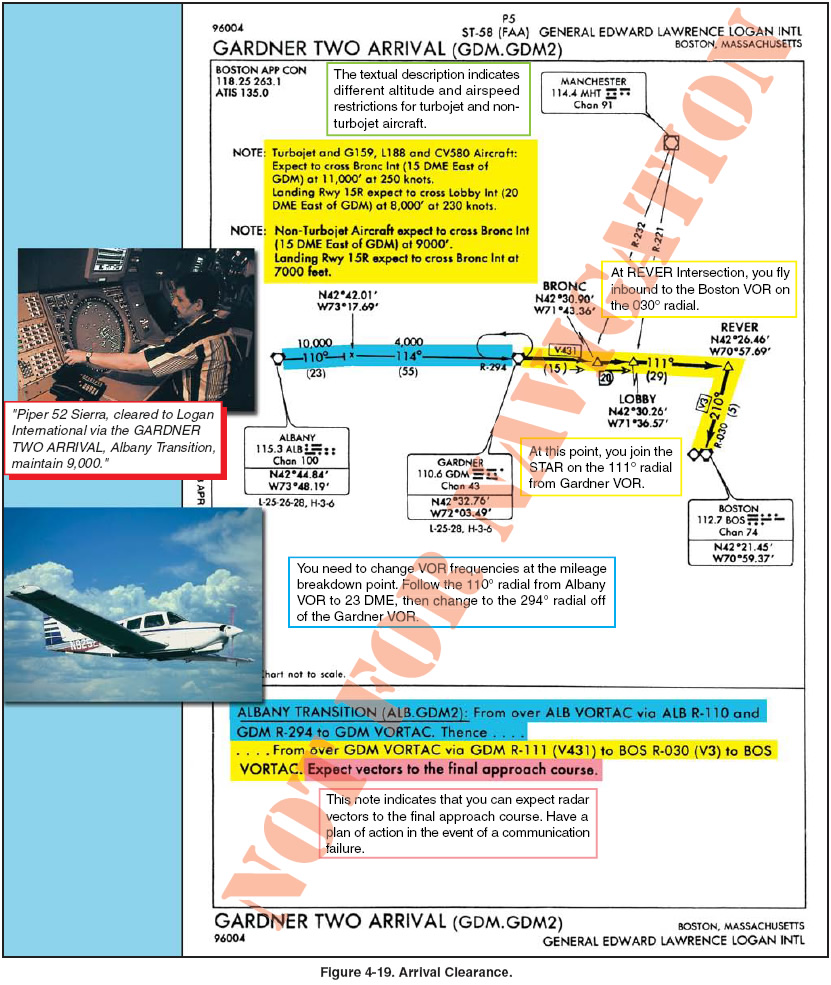 |
|
| INSTRUMENT PROCEDURES HANDBOOK |
|
ARRIVAL PROCEDURES You may accept a STAR within a clearance or you may file for one in your flight plan. As you near your destination airport, ATC may add a STAR procedure to your original clearance. Keep in mind that ATC can assign a STAR even if you have not requested one. If you accept the clearance, you must have at least a textual description of the procedure in your possession. If you do not want to use a STAR, you must specify “No STAR” in the remarks section of your flight plan. You may also refuse the STAR when it is given to you verbally by ATC, but the system works better if you advise ATC ahead of time. PREPARING FOR THE ARRIVAL As mentioned before, STARs include navigation fixes that are used to provide transition and arrival routes from the en route structure to the final approach course. They also may lead to a fix where radar vectors will be provided to intercept the final approach course. You may have noticed that minimum crossing altitudes and airspeed restrictions appear on some STARs. These expected altitudes and airspeeds are not part of your clearance until ATC includes them verbally. A STAR is simply a published routing; it does not have the force of a clearance until issued specifically by ATC. For example, MEAs printed on STARs are not valid unless stated within an ATC clearance or in cases of lost communication. After receiving your arrival clearance, you should review the assigned STAR procedure. Obtain the airport and weather information as early as practical. It is recommended that you have this information prior to flying the STAR. If you are landing at an airport with approach control services that has two or more published instrument approach procedures, you will receive advance notice of which instrument approaches to expect. This information is broadcast either by ATIS or by a controller. It may not be provided when the visibility is 3 statute miles (SM) or better and the ceiling is at or above the highest initial approach altitude established for any instrument approach procedure for the airport. [Figure 4-19 on page 4-20]
For STAR procedures charted with radar vectors to the final approach, look for routes from the STAR terminating fixes to the IAF. If no route is depicted, you should have a predetermined plan of action to fly from the STAR terminating fix to the IAF in the event of a communication failure. REVIEWING THE APPROACH Once you have determined which approach to expect, review the approach chart thoroughly before you enter the terminal area. Check your fuel level and make sure a prolonged hold or increased headwinds have not cut into your fuel reserves because there is always a chance you will have to make a missed approach or go to an alternate. By completing landing checklists early, you free yourself to concentrate on the approach. In setting up for the expected approach procedure when using an RNAV, GPS, or FMS system, it is important to understand how multiple approaches to the same runway are coded in the database. When more than one RNAV procedure is issued for the same runway, there must be a way to differentiate between them within the equipment’s database, as well as to select which procedure you want to use. (Multiple procedures may exist to accommodate GPS receivers and FMSs, both with and without VNAV capability.) Each procedure name incorporates a letter of the alphabet, starting with Z and working backward through Y, X, W, and so on. (Naming conventions for approaches are covered in more depth in the next chapter.) [Figure 4-20]
|

